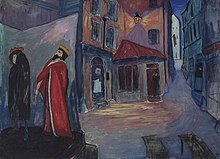Female figurine (Werefkin)
Female figurine is the title of a picture that the Russian artist Marianne von Werefkin painted around 1909. The work belongs to a German private collection. It is not signed, dated and does not have an inventory number.
Technology and dimensions
The picture is a gouache with pen and ink drawing on cardboard , 69 × 46 cm.
iconography
The depiction is a female figurine of the Werefkin. It shows a costume design for an actress who appeared in a play from the 17th or 18th century. She is dressed in a pink top with a large cleavage and sleeves that reach up to the elbows and are adorned with fringes. A wasp waist leads to the sweeping Panier à coudes . The skirt reaches the floor, the feet are covered.
Theater, concert and exhibition visits
Stage art captivated the Werefkin all her life. This is illustrated not only by several of her pictures, but also by hundreds of sketches that she made during various performances. But she also reported in letters from Kownow to Jawlensky in Munich in 1911 about visits to the theater, e . For example: "On Thursday theater [...], on Friday theater [...], on Saturday theater [...], today theater", or from Ascona to her friends Carmen and Diego Hagmann in Zurich, Werefkin speaks of visits to various stage plays. We also know of her enthusiastic participation in the staging of the performances of the dancer Alexander Sacharoff in Munich and Lugano .
From the original text of “Lettres à un Inconnu” you can learn a lot about “certain people or situations in the Munich district”, e.g. B. about Jawlensky's and Werefkins joint visits to the theater, concerts and exhibitions in Munich, their relationships with domestic and foreign artists, Russian and German politicians, the Bavarian nobility and their travels at home and abroad. In March 1905 - before she started painting again in 1906 - Werefkin gained new impressions of color values by visiting the Japanese theater, interestingly enough .

The artist is unlikely to have known boredom in Lithuania, Munich or Murnau . Their sketchbooks make this clear. Wherever there was something attractive for her as a painter to see, she mingled with the people, visited fairgrounds , popular theaters or beer gardens .
With so much familiarity with the performing arts, it would be surprising if no further evidence of practical work of Werefkin in this profession would have come down to us. As far as this is concerned, there is a sheet of paper with three male figurines with wigs, which in style and color go well with the aforementioned female figurine with the hoop skirt.
Bibliography
- Clemens Weiler : Alexej Jawlensky. Cologne 1959.
- Helga Lukowsky: Jawlensky's evening sun, the painter and the artist Lisa Kümmel . Königstein / Taunus 2000, ISBN 3-89741-050-8 .
- Brigitte Roßbeck: Marianne von Werefkin, The Russian from the circle of the Blue Rider. Munich 2010, ISBN 978-3-88680-913-4 .
- Bernd Fäthke : Marianne Werefkin: Clemens Weiler's Legacy. In: Tanja Malycheva, Isabel Wünsche (Ed.): Marianne Werefkin and the Women Artists in her Circle. Leiden / Boston 2016, ISBN 978-90-04-32897-6 , pp. 8-19, here pp. 14-19; JSTOR 10.1163 / j.ctt1w8h0q1.7 (English)
Individual evidence
- ↑ Marianne Werefkin, exh. Cat., August Macke Association House: Marianne Werefkin, Color bites my heart. Bonn 1999, p. 110
- ↑ Bernd Fäthke: Marianne Werefkin. Munich 2001, p. 236, ISBN 3-7774-9040-7
- ↑ Alexej Jawlensky: Memories In: Clemens Weiler (ed.), Alexej Jawlensky, Heads-Face-Meditations , Hanau 1970, p. 110
- ^ Theo Kneubühler: The artists and writers and Ticino (from 1900 to the present). In: exhib. Cat .: Monte Verita, Mountain of Truth, Local Anthropology as a contribution to the rediscovery of a modern sacred topography. Ascona 1978, p. 157
- ↑ Clemens Weiler (ed.), Marianne Werefkin, Letters to an Unknown 1901–1905, Cologne 1960. Weiler translated about a quarter of the entire text.
- ↑ Gabrielle Dufour-Kowalska: Marianne Werefkin, Lettres à un Inconnu. Paris 1999, Vol. III, p. 153

